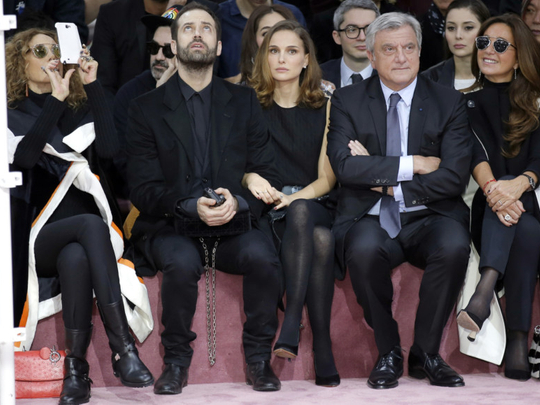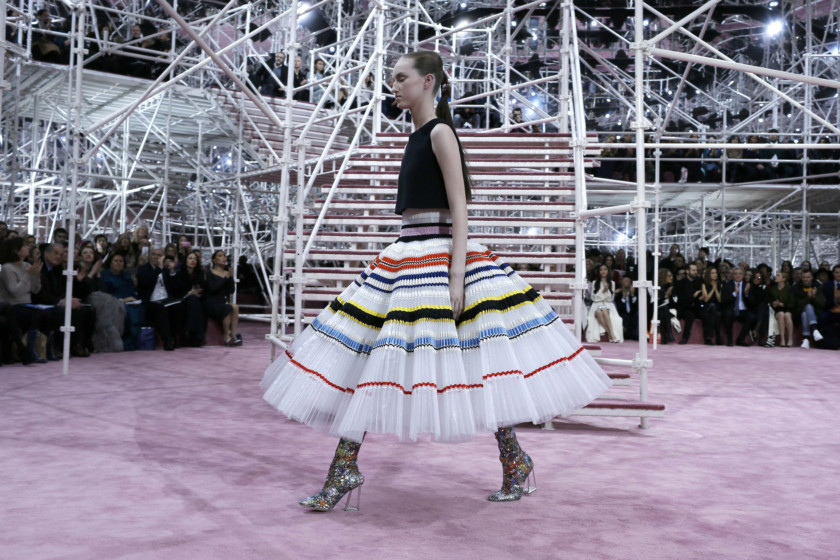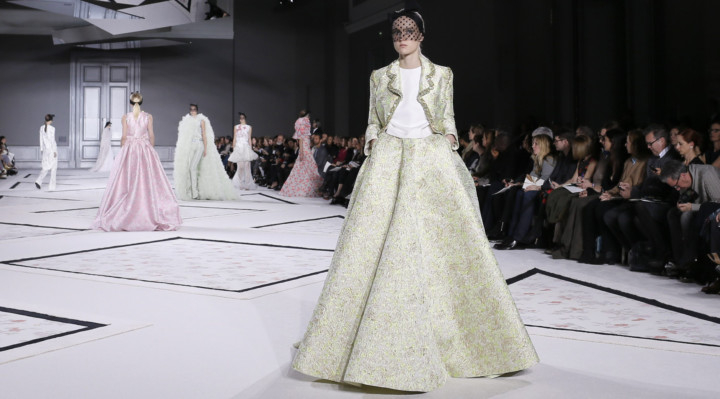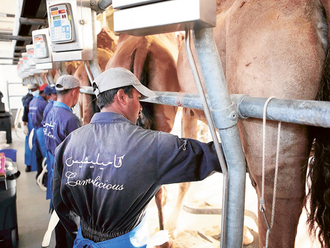
The stars were aligned at Dior’s Haute Couture fashion show in Paris on Monday.
First, American-Israeli actress Natalie Portman — the advertising face of Dior’s “Miss Dior” perfume — was sitting in the front row, somewhat less stiffly than her Queen Padme persona from the Star Wars prequels.
Second was the spring-summer collection itself: all groovily Barbarella with fluorescent orange boots and skintight catsuits with flower-power patterns worn by models descending from a multi-level space-opera set purpose-built in the gardens of Paris’s Rodin Museum.
Third was David Bowie’s early years London pop washing out of the sound system, including tunes performed by his stage alter ego Ziggy Stardust.
It was very retro space age — yet designer Raf Simons injected the show with a look at once sexy and light.
“I was always thinking of the future for so many years and I was always anti-romanticising the past, but the past can be beautiful too,” he said.
The colourful garments, he said, incarnated “the romance of the ’50s, with the experimentation of the ’60s and the liberation of the ’70s”.
His ambition was for “something wilder, more sexual, strange and certainly more liberated for the haute couture and for women”.
Bright, very bright colours, lines and swirls competed for attention on the outfits, which ranged from Dior’s trademark thin-waisted, flouncy dresses to second skins to mid-thigh tunics with latex leggings. All carried on exquisitely stilettoed shoes and eye-catching boots.
It was as if Austin Powers were piloting the spaceship, headed for Woodstock with an ultra-glam female party crew on board.
Indeed, Dior itself described the collection as a time-travelling “hallucinogenic amalgamation” in its production notes.
The idea, it said, was to subvert the typical Dior “femme fleur” image it has built up over the years.
Flower power, indeed: a nostalgic trip harking back to a breezier, maybe more innocent, time when fashion, leisure, music and the beginning of mass travel promised what seemed a bright future of free love and world peace.
Current events in the news may give the lie to that promise, but maybe that’s why the privileged crowd watching the show applauded so heartily — hailing this image of hope over reality.
The VIP crowd putting its well-manicured hands together included Chinese model-actress Angelababy, 1960s and 1970s American model Marisa Berenson, and Bernard Arnaud, the head of the LVMH luxury goods empire that controls Dior.
Backstage, the couturieres who handmade the garments spoke about the challenge of working with material like PVC, which was made into see-through jackets for some of the numbers.
“We had to learn to work with it — we’d never done that before... find threads that can’t be seen, that don’t break,” said one, who gave her first name as Florence.
Simons said he sought to invoke the way women in the 1960s and 1970s expressed political views through their bodies and what they wore.
The bodysuit, for instance, was “not changing the body — it is the body, so in that sense I think it’s interesting to communicate directly with purely the form of the body”.
Challenging the often-grim news from around the world was a priority, he admitted.
“This for me is also about love. The ’60s and ’70s were much about love, so it was a conscious decision to go there right now,” Simons said.
Next up on Tuesday are shows by Chanel, Giorgio Armani Prive and Stephane Rolland.
Also at the couture shows on Monday:
Valli’s flower women
It’s not just at Dior; Italian designer Giambattista Valli excels in channeling flowers.
It’s dangerous ground to tread on to compare designers to one another. Yet trans-pollination is ubiquitous in Paris.
So I’ll say it: There was more than an echo of the age-old Parisian house in the Italian designer’s Monday show in its full skirts, large peplums with echoes of the Fifties, diaphanous tulle and floral embroideries.
But they were only echoes. Valli owned the styles completely, and with a more muted pastel palette - he stunned with the most ambitious couture-work seen all day.
Elizabethan ruffs pushed the silhouette in a northern direction from the neck, or brought it down with net visors that covered the top part of the face and Fifties head bows.
Skirts in incredible, billowing, voluminous A-line white tulle had guests audibly gasping.
It’s coming up to four years that 48-year-old designer has been creating couture. Understandably his show is among the calendar’s most eagerly awaited.
Schiap is back
Schiaparelli’s couture show went back to the light artistry that the couturier, Elsa, was famed for - and improved in focus, following the departure of the more heavy-handed designer Marco Zanini.
The two-piece menswear tuxedo that opened the show — diaphanous yet authoritative — set the period: the Katherine Hepburn of the glamorous Thirties.
And the deceptively simple burnt orange leather coat that exploded on its back with a giant effervescent bow, and 3D heart appliques stabbed with pins, set the tone.
Carla Bruni, on the front row, gasped in delight.
After two off-seasons, the subtle, playfulness of “Schiap” — the formidable rival of Coco Chanel who befriended surrealist Salvador Dali, invented shocking pink and gave the world the lobster dress — was truly back after her 60 year sleep.
The design team built on the creative skeleton Zanini had started to trace, but gave it true style.
A sharp black bolero cut a dashing silhouette, and a Golden Oldie emerald green satin dress featured embroidered hands on the back, as if the model were slowly being undressed.















